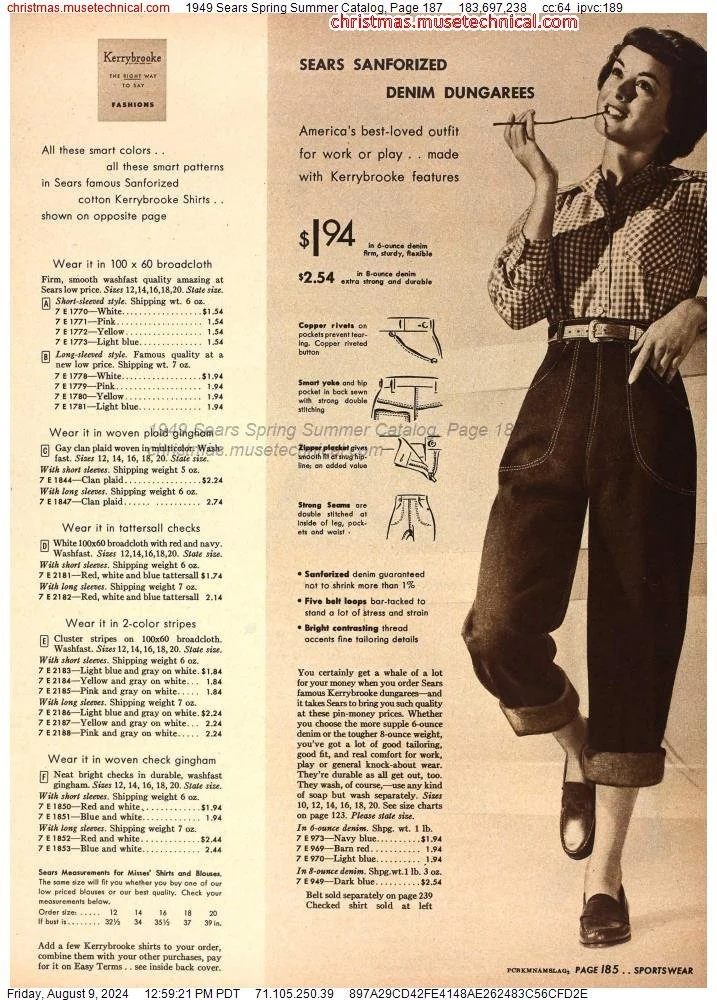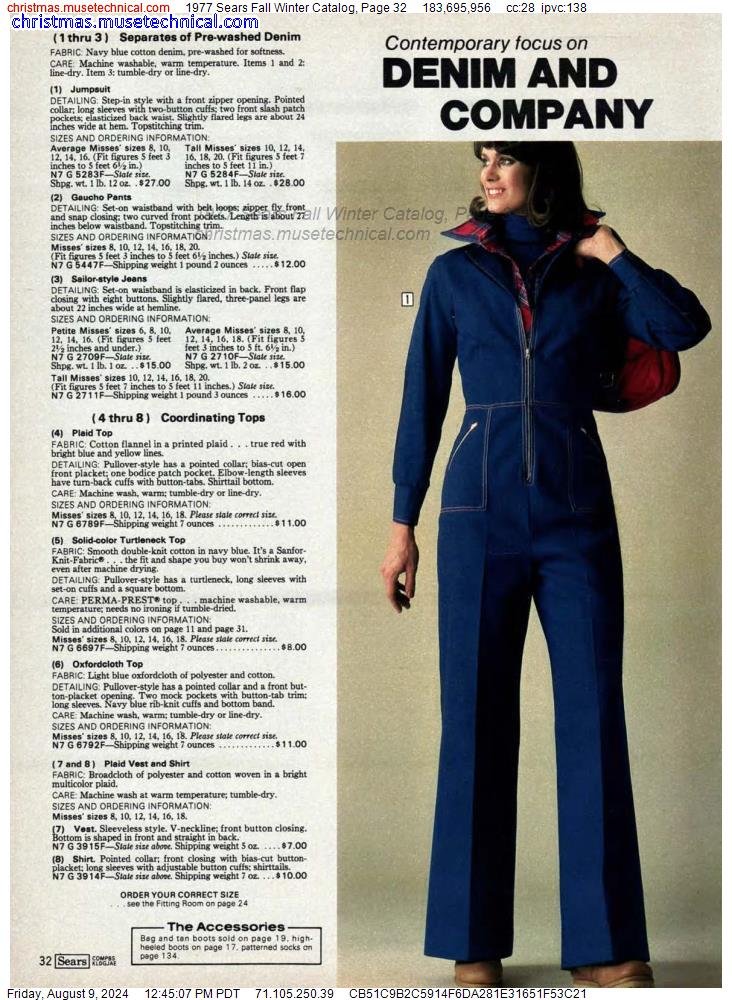90 Years of Women’s Denim
90 Years of Style: A Journey Through Women's Denim





























































1930s - The Beginning
2024 marks 90 years since the “official” introduction of women’s denim. Of course, these sturdy and practical pants were already a staple for working men since their introduction in 1873, and women often borrowed their husbands' or brother’s denim for their own work...
But it was in 1934, 14 years after women secured the right to vote nationally, that Levi Strauss changed the game when they introduced the first denim pants made with women in mind.
It's this moment in history that we see denim go from a workwear fabric to a fashion trend. It’s also one of the most classic examples of trickle-up fashion (something I talked more about in my nautical fashion history video).
Origins of Denim
Denim's origins trace back to two cities: Genoa, Italy, and “Nimes”, France. The term 'denim' comes from 'serge de Nimes,' meaning 'serge from Nimes,' while 'jeans' derives from 'Genes,' the French word for Genoa. These locations were pivotal in developing the fabric that would eventually become a global staple.
Lady Levi's
Lady Levi’s were initially developed for Western women wearing Levi’s jeans on farms and ranches. The new line also targeted women vacationing at dude ranches, where guests from eastern states or even Europe would experience life on cattle or horse ranches.
The rollout was slow, but by the 1950s, Lady Levi’s were sold nationwide. A new zipper fly was introduced, they picked up the “jeans” nickname, and it seemed to take teens, rebellious rock n rollers, and celebrities by storm.
I’ll come back to this decade in a bit because it’s my current favorite way to wear denim. But it’s so interesting to look through photos from each subsequent decade and see how the styles evolved.
1960s - Narrow Silhouettes
In the 1960s, denim styles became narrower, evolving into a silhouette that closely resembles what we now call skinny jeans. This period saw denim being embraced by the counterculture movement, from Beatlemania to Woodstock, and everything in between.
Gap's Arrives on the Scene
A big moment for denim history was in 1969, when The Gap first opened their doors - initially selling only Levis and records, this focused approach really caught the attention of the younger generations who were embracing this bold and rebellious look.
1970s - Customization and Flare
The 1970s continued the counterculture movement from the 1960s, with a strong anti-establishment attitude. This movement encouraged self-expression, which led to a lot of different ways denim was worn within each subculture.
Hippies and bohemians embraced bell-bottom jeans, often with anti-war patches and pins.
A surge in the feminist movement saw women wearing jeans more frequently as a symbol of liberation and equality.
Punks adopted ripped, safety-pinned, and distressed jeans as part of their rebellious look.
In contrast, disco enthusiasts, favored form-fitting, high-waisted jeans that accentuated their curves for dance clubs.
Soul Train which was a popular television show that celebrated Black culture and music shared styles from the disco scene but often blended style with cultural pride.
And in the late 1970s, we saw a rise in the popularity of fitness, partly due to figures like Jane Fonda, which lead to stretchier denim fits.
1980s - High Waists and Acid Wash
In the 1980s, denim styles featured high waists, and the iconic acid wash look emerged. Denim jackets became a staple, often paired with matching jeans for a double denim look. This era also saw the rise of designer jeans, with brands like Calvin Klein and Guess making their mark.
Gloria Vanderbilt (Anderson Cooper’s mother) released her own line of jeans - known for their flattering fit and signature swan logo, becoming a symbol of status and style during this decade.
Click Each Image to Shop 80s Inspired Denim
1990s - Baggy and Bold
The 1990s denim styles were characterized by big, wide silhouettes. This was the decade of baggy jeans, overalls, and the return of flared jeans. During this time, Gap stopped selling Levi’s and introduced their own denim line, emphasizing comfort and casual wear.
Gap’s Dance Approach
Gap’s approach to denim marketing in the 90s and early 2000s included iconic dance commercials, showcasing how their jeans could move with you. These ads featured choreographed dance routines, highlighting the versatility and comfort of their denim.
Click Each Image to Shop 90s Inspired Denim
2000s - Low Rise and Embellishments
The 2000s saw denim styles becoming slimmer again, with low-rise jeans taking center stage. This period was all about rips, studs, and embellishments, making denim a key part of the edgy, rock-inspired fashion of the time.
2010s - Return of Skinny Jeans
Skinny styles were still the go-to in the 2010s, but thank goodness the rises started to get higher. This looks was really reminiscient of the 1960s styles, and considering the entire twee era was inspired by 60s mod fashion, that makes a lot of sense. The cyclical nature of fashion trends often reflects broader economic and societal trends, with a return to classic styles during times of uncertainty.
Which leads us to present day - a quick look at “denim focused” brands shows that essentially all styles are available. So instead of returning to one classic style, is the overwhelming uncertainty of the world making us return to ALL classic styles?
Though, we are leaning towards wider legs and higher waists, with comfort and versatility being key. This shift towards comfort and practicality reflects a broader trend towards sustainability and mindful consumption - and while I think that’s great and something that should never go out of style, I can’t help but wonder if that too is a reflection of the times.
Click Each Image to Shop 00s + 10s Inspired Denim
2020s - Wider and Higher Waists
Today, in the 2020s, denim styles are again leaning towards wider legs and higher waists. Comfort and versatility are key, with many people opting for relaxed fits that can be dressed up or down. This shift towards more comfortable, practical styles reflects a broader trend towards sustainability and mindful consumption.
A Guide to 1950s Casual Style
Back to my current favorite style of denim - the high waisted roomy legged rolled cuff! If you’d like to explore ways to wear this style, I encourage you to check out my blog post below, that goes through each element of this classic style. I’ll be updating all the shopable links throughout September, so you have all the best resources to recreate that look + beyond!
Last but not least
And to wrap things up, I’m including some of my favorite non-pant denim links below, because who doesn’t love a Canadian Tuxedo? All jokes aside, you can’t go wrong with denim as long as you have the confidence and accessories to rock it all together.



























